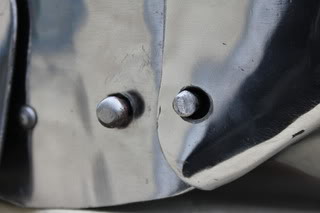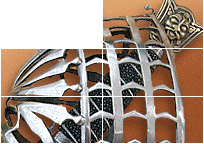| Author |
Message |
|
Chris Mann
Location: california Joined: 02 Mar 2011
Posts: 7
|
 Posted: Wed 03 Aug, 2011 11:18 pm Post subject: Attaching a Spring Catch or Pin to Helmet Posted: Wed 03 Aug, 2011 11:18 pm Post subject: Attaching a Spring Catch or Pin to Helmet |
 |
|
|
Hey guys, I have GDFB Sallet and I was concerned about the inability to either keep the visor raised or kept in the down position. I was thinking of solutions and the only thing that I could think of was to add either a spring pin or catch to the helmet but I was wondering if any of you out there have either done this yourself or know of someone who has with success? It would be much appreciated. Thank you
|
|
  |
 |
Michael B.
Industry Professional

Location: Seattle, WA Joined: 18 Oct 2007
Posts: 367
|
 Posted: Thu 04 Aug, 2011 12:42 am Post subject: Posted: Thu 04 Aug, 2011 12:42 am Post subject: |
 |
|
This is the latch on my sallet. The latch is beveled to the visor can slip down, there's a this piece of steel that connects to the "button" to release the latch. It works great and can actually undo it myself when wearing all my steel. I could drum of some more photos tomorrow night if you'd like.

www.bearmountainforge.com
Michael Bergstrom
|
|
   |
 |
|
Chris Mann
Location: california Joined: 02 Mar 2011
Posts: 7
|
 Posted: Thu 04 Aug, 2011 1:14 am Post subject: Posted: Thu 04 Aug, 2011 1:14 am Post subject: |
 |
|
|
ya, I would really appreciate more pics. I'm gonna be doing it myself most likely and that way seems to be the most common. I really appreciate it
|
|
  |
 |
Sean Flynt

|
|
   |
 |
|
Colt Reeves
|
 Posted: Thu 04 Aug, 2011 7:22 am Post subject: Posted: Thu 04 Aug, 2011 7:22 am Post subject: |
 |
|
I think I know what is being done, but could someone post a picture of the catch inside the helmet so I know how it works for sure?
"Tears are for the craven, prayers are for the clown.
Halters for the silly neck that cannot keep a crown.
As my loss is grievous, so my hope is small.
For Iron, Cold Iron, must be master of men all..."
-Cold Iron, Rudyard Kipling
|
|
  |
 |
Sean Flynt

|
|
   |
 |
Michael B.
Industry Professional

Location: Seattle, WA Joined: 18 Oct 2007
Posts: 367
|
|
   |
 |
|
Chris Mann
Location: california Joined: 02 Mar 2011
Posts: 7
|
 Posted: Thu 04 Aug, 2011 2:48 pm Post subject: Posted: Thu 04 Aug, 2011 2:48 pm Post subject: |
 |
|
|
Wow, that really helps. Thank you. It looks like some nice work on your part, how long did it take you to complete, if I might ask?
|
|
  |
 |
|
Colt Reeves
|
 Posted: Thu 04 Aug, 2011 9:00 pm Post subject: Posted: Thu 04 Aug, 2011 9:00 pm Post subject: |
 |
|
Thanks guys. That's pretty much how I thought it was put together, but wanted to know for sure.
"Tears are for the craven, prayers are for the clown.
Halters for the silly neck that cannot keep a crown.
As my loss is grievous, so my hope is small.
For Iron, Cold Iron, must be master of men all..."
-Cold Iron, Rudyard Kipling
|
|
  |
 |
Sean Flynt

|
|
   |
 |
Jean Thibodeau

|
 Posted: Fri 05 Aug, 2011 9:50 pm Post subject: Posted: Fri 05 Aug, 2011 9:50 pm Post subject: |
 |
|
| Sean Flynt wrote: | | I happened to have a sallet spring for my project. If you don't have one and don't want to make one from scratch you might experiment with a narrow saw blade. Seems like one should be able to just cut to length, grind the teeth flat and drill for the rivets/pins. No heat treatment needed. |
Good idea since a mild steel one may have enough spring but can deform easily if overstressed and don't have much strength for a positive lockup.
I guessing you are thinking of a hacksaw blade cut to length.
Should be easy to shape using a dremel cut off wheel.
One could use a section and do a destructive test on it to see if it's too brittle or not ? If a bit too hard and brittle I would polish it bright and then put it on the electric element on my stove and heat it up until it turned blue: This should soften a hardened steel from 60 R.C. + down to the 45/50 R.C. of a spring temper.
Not very expensive to cut up a saw blade and experiment until one has the right amount of springiness versus hardness.
You can easily give up your freedom. You have to fight hard to get it back!
|
|
  |
 |
Sean Flynt

|
|
   |
 |
Jean Thibodeau

|
 Posted: Sat 06 Aug, 2011 10:18 pm Post subject: Posted: Sat 06 Aug, 2011 10:18 pm Post subject: |
 |
|
| Sean Flynt wrote: | | Appalachian folks made knives the same way, breaking blades out of worn or broken saw blades. |
Used a file to make a long spear point a long time ago but since I didn't lower it's harness a bit, it broke on a wood stump when I tested it with a light tap. :cry: The next one I put in the kitchen oven set at around 600 degrees F. for a while and let it cool slowly ! Anyway, a little trick to soften too hard steel without doing a full re-heat treat.
This was a long long time ago so I don't remember the exact technical details and I think I " chickened out " and didn't test that second spear point on the log. ;) :lol:
I did do a full eat treat once in Shop Class too many decades ago to mention and we where shown how to control the hardness using the colour changes of the steel: A straw colour for very very hard ( 60/62 R.C. ) and deep blue for ( 52/55 R.C. )
The stove top trick or oven trick is to soften a too hard blade by heating it a bit higher than it was when originally tempered as a very hard file. Depending on the steel this might work well or cause stresses to the steel ? More knowledgeable people would have to give us their opinion on this and how successful or not it might be. ;) :D :cool:
You can easily give up your freedom. You have to fight hard to get it back!
|
|
  |
 |
|
|

